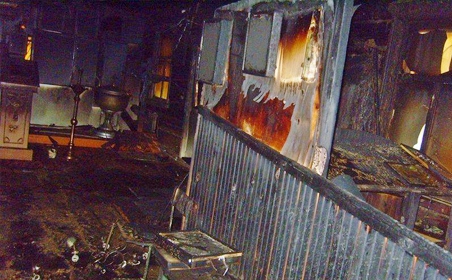
Attacks on Churches and Mosques in Russia on the Rise
Publication: Eurasia Daily Monitor Volume: 10 Issue: 218
By:

Against the backdrop of anti-Islamic hysteria launched by the Russian government’s propaganda machine, it is hard not to notice the negative trend in such a delicate matter as interfaith dialogue in the country. Deliberately or not, a negative image of Muslims has been firmly established in Russia. A man with a beard or a woman wearing the hijab are increasingly perceived in society as extremists
It was inevitable that this attitude would result in a backlash by Muslims in Russia; the question only was whether Muslims would aim their opposition at politicians or Christians. Muslims are in fact becoming aggressive toward Christians because they are associated with the authorities. The Russian Orthodox Church also contributes to the trend because it aspires to become a dominant force in the society (https://www.nytimes.com/2013/03/19/world/europe/russian-regions-hijab-ban-puts-squeeze-on-muslims.html?pagewanted=all&_r=0; https://www.globalpost.com/dispatch/russia/100209/russian-orthodox-church).
The church bases its aspirations on the fact that ethnic Russians are an absolute majority in the country (https://statistika.ru/naselen/2007/12/05/naselen_9686.html). However, 11–15 percent of Russians are atheists and a quarter see themselves outside of any church, so at most 40–45 percent of the population can be considered Christians. At the same time, restrictions remain on the activities of Christian Protestant churches (https://www.sova-center.ru/religion/publications/secularism-limits/2005/01/d3385/). It is possible that the Russian Orthodox Church realizes the actual weakness of its position in society and that is why it wants Russian government help in boosting its influence in society.
Since Muslims cannot challenge the pressure of the Orthodox Church in Moscow, muted protests are unfolding in the provinces that are likely to end badly. Meanwhile, arson attacks on churches have been reported in Muslim-populated areas. For example in Tatarstan, there have been eight arson attacks on churches and one arson attack on a mosque since August 2013. Bearing in mind that the first attack on the Farhad Mosque in Kazan took place on August 13 (https://news.prokazan.ru/news/view/83544), the following attacks on churches can be regarded as reprisal attacks and a signal that Muslims will not tolerate a situation in which Moscow dictates how and when beards or hijabs can be worn. The authorities did their best to present the attacks as hooliganism. In the past four months, churches have come under attack in these respective areas: In the village of Sloboda Petropavlovskaya in Novosheshminsky district on the night of August 15, in the village of Ivanovka in Leningorsky district on September 13, in the village of Lenino in Novosheshminsky district on November 1, in the village of Sokolka in Bugulminsky district on the night of November 14, in the city of Chistopol on November 17, in the village of Lenino in Novosheshminsky district on November 17, in the village of Albai in Mamadyshsky district on November 28, and, finally, in the village of Kreshchennye Kazyli in Rybnoslobodsky district on November 29 (https://www.moidagestan.ru/blogs/46866/36315). In the end, the police was forced to admit that the arson attacks may have been specifically organized and reclassified these actions as terrorist attacks (https://www.rg.ru/2013/11/29/reg-pfo/prokuratura-anons.html).
Tatarstan is not the only region where religious buildings are being attacked. Arson attacks also take place in the North Caucasus. On November 9, 2008, an Orthodox church was set on fire in in the city of Karabulak in Ingushetia. Two months later, on January 2, 2009, it was set on fire again (https://www.pravda.ru/news/accidents/03-01-2009/298101-cerkov-0/). In 2010, two churches and one Christian prayer house were burned down in the village of Ordzhonikidzevskaya in Ingushetia and in the city of Karachaevsk in Karachaevo-Cherkessia (https://kavkaz.ge/2010/11/02/v-karachaevo-cherkesii-podozhgli-dva-xrama-i-molelnyj-dom/). On June 21, 2010, Novaya Zhizn, an Evangelical Baptist church, was burned down. On July 15, 2010, Pentecostal pastor Artur Suleimanov was shot to death near a prayer house (https://www.protestant.ru/news/prosecution/ofchristians/article/65621). On April 30, 2011, the Shaoninsky church in Karachaevo-Cherkessia was set on fire. This past July, the rabbi of the local Jewish community in the city of Derbent in Dagestan was attacked (https://www.vesti.ru/doc.html?id=1109702).
Arson attacks on mosques are frequent in areas where Christians are the majority. On September 27, a Muslim prayer house was burned down in the village of Kapustin Yar in the Akhtubinsk district of Astrakhan region (https://www.ansar.ru/rfsng/2013/10/01/43753). On October 22, a Muslim prayer house came under attack in the city of Volgograd. That attack may have been a reaction to the female suicide bomber attack on October 21, which killed six passengers on a bus and wounded 28 (https://ria.ru/infografika/20131021/971555739.html).
So many attacks have taken place that they can no longer be seen as isolated cases. And these do not include the dozens and even hundreds of attacks and murders of Christian clergy in robberies, or the dozens of attacks on Muslim clergymen in the North Caucasus in recent years. Tensions are increasing, especially in areas where the government propaganda campaign against jihadists runs strong.
Although the Orthodox Church recognizes that all these attacks are attempts to foment inter-religious hostility in society, it does little to prevent such acts. On the contrary, it is completely unclear why a cathedral is being erected on the main square of the capital city of Ingushetia, Magas, even though no Christian Orthodox believers live in the city (https://www.interfax-religion.ru/?act=news&div=53233). It is unclear why another Orthodox church is being built in Grozny (https://www.gazeta.ru/news/social/2011/01/18/n_1661462.shtml) when only a couple of dozen parishioners at most regularly visit the existing church (https://expert.ru/russian_reporter/2013/19/svoi-chuzhie/). This unwarranted imposition of Orthodox churches in Muslim regions, against the backdrop of the rise of jihadist sentiment, is unlikely to increase religious tolerance in the region.
Observing what is going on in the Muslim regions of Russia, one invariably arrives at the conclusion that everything the Russian authorities do comes back at them in the end. If no quick measures are taken, inter-religious tensions in Russia may become increasingly irreversible.




